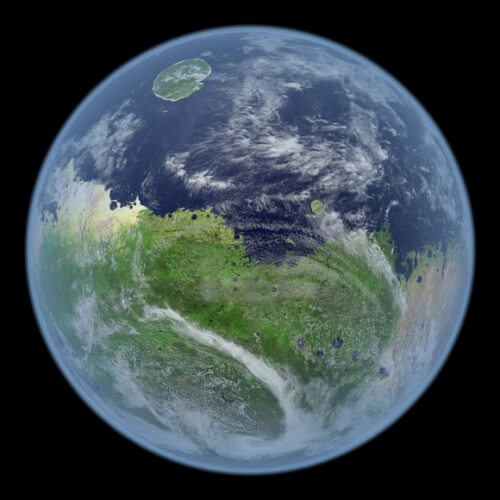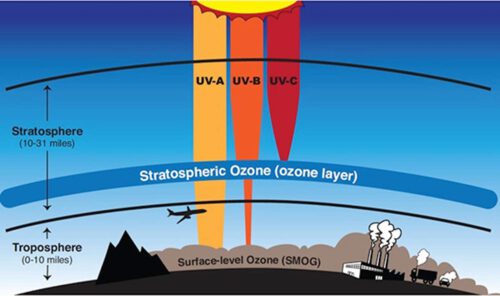The ozone layer and the greenhouse effect both ultimately help control the amount of ultraviolet (UV) radiation from the sun that reaches the Earth's surface, and the amount of infrared (IR) radiation that escapes into space. Both of these forms of radiation have a critical effect on the habitability of a planet. Controlling this radiation is clearly a pressing matter for Earth. But it poses a challenge to those who dream of establishing colonies on Mars
By: Gareth Dorian, Postdoctoral Fellow in Space Sciences, University of Birmingham and Ian Whittaker, Lecturer in Physics, Nottingham Trent University.

In a rare example of environmental success, the United Nations has just announced that it believes the damage done to the ozone layer that protects the Earth will be fully restored by 2050. This is in stark contrast to the growing concern about the climate emergency caused by the increasing greenhouse effect.
The ozone layer and the greenhouse effect both ultimately help control the amount of ultraviolet (UV) radiation from the sun that reaches the Earth's surface, and the amount of infrared (IR) radiation that escapes into space. Both of these forms of radiation have a critical effect on the habitability of a planet. Controlling this radiation is clearly a pressing matter for Earth. But it poses a challenge to those who dream of establishing colonies on Mars.
UV radiation is a form of light whose wavelength ranges from 10 to 400 nanometers (one nanometer is a length of 0.000000001 meters). It is shorter and more energetic than visible light. For comparison, the wavelength of a typical 4G telephone network is several tens of centimeters. UV radiation from the sun can increase the production of essential vitamin D in human skin, but excess levels can cause a range of health problems including sunburn, skin cancer and cataracts. It can also harm plants and damage the yield of crops.
On Earth, almost all UV radiation from the sun is absorbed by the ozone layer, a region of the Earth's atmosphere located at an altitude of approximately 15-30 km. Without her, life on Earth would be in dire straits. Ozone is a molecule that is found in nature and consists of three oxygen atoms. The formation of this molecule is strictly balanced by a process called the Chapman cycle, in which UV light breaks down ozone into a single oxygen atom and an oxygen molecule. Factors in nature can act as catalysts for this, such as volcanic activity and the Earth's radiation belts. The first observations that the ozone balance was in trouble were made in the 1987s. It has been determined that the widespread use and emission of certain chemicals such as chlorofluorocarbons (CFCs) have caused severe damage to the ozone layer. This prompted the international community to adopt the Montreal Protocol in XNUMX—so far the only UN agreement ever ratified by all member states.

the ozone layer. NASA
IR radiation has a slightly different effect on Earth and other stars. All objects emit a range of light that depends on their temperature. An object with an average temperature of a million degrees will emit mostly X-rays (as some star systems emit).
The strongest emission from the Sun, with an average temperature of 5,700°C, is in visible light (specifically yellow), while objects at room temperature emit in the IR. This is why people appear clearly on an IR camera.
Sunlight, mainly in visible wavelengths, passes through the atmosphere and heats the earth's surface. To maintain thermal equilibrium, the Earth emits light back into space, but does so in the IR. Certain molecules in the atmosphere allow a large amount of visible light to pass (which is why they are invisible to the human eye) but reflect or scatter the IR light emitted by the earth's surface - making them warmer.
The chemicals involved in this process are the ones we know as greenhouse gases, carbon dioxide is the most familiar but methane and nitrous oxide are also important. What complicates the climate problem is that both water vapor and ozone itself are all greenhouse gases.
This is one of the many reasons why climate modeling is a very complex subject. The greenhouse effect itself is usually described as a bad thing, but in fact it is essential to life. With no greenhouse effect at all, it is relatively easy to show that the Earth would have an average temperature of -24°C instead of the current temperature of 14°C.
But as with many natural processes, human activity has altered the greenhouse effect to such an extent that this essential feature of the planet's habitability is now becoming dangerous. There is ample evidence that humans have increased the amount of greenhouse gases in the atmosphere, and consequently the global average temperature.
Lessons for colony founders
The challenge for future colonists who hope to live on Mars is the opposite of that on Earth. Its thin atmosphere means that although there is a high concentration of carbon dioxide, the greenhouse effect is quite weak and needs to be increased. But recent research has shown that even if they vaporize the carbon dioxide left in Martian rocks and put it into the atmosphere, there won't be enough of it to create a greenhouse effect that would be enough to make the planet warm enough for habitation.
Compared to Earth, Mars also has little ozone, and Mars' thin atmosphere allows much more UV from the Sun to reach Earth. This radiation is so strong that the top few centimeters of Martian soil are actually sterilized once a day, and any complex molecules that might be useful for life are destroyed.

So what can we do to make the climate more Earth-like? Previous ideas included placing a giant magnet in space near Mars to protect the atmosphere and launching nuclear weapons on the Martian surface.
In a recent article, it is suggested to use silica airgel - a very light synthetic material that is produced by taking a gel and replacing the liquid component with a gas - to cover areas on the surface of Mars. It will effectively act like an artificial ozone layer, being almost transparent in visible light but blocking UV.
The use of silica airgel will also rapidly heat the ground beneath it to above the freezing temperature of water through an artificial greenhouse effect. Placing silica airgel shields over regions of the Martian surface with a lot of ice would create an environment suitable for plant growth, with minimal human intervention.
This alone cannot warm the Red Planet, because Mars is constantly losing its atmosphere to the solar wind. But it would at least provide a much less hostile environment, on a smaller scale, for future visitors. This is still a difficult possibility, but is now the most practical way to make regions of Mars a less extreme environment.
In the end, the success of the Montreal Protocol shows the ability of international collective action to solve an environmental problem, and also that environmental change is possible on a planetary scale within a fairly short period of time. It also clearly shows how susceptible stellar environmental processes can be to artificial changes, for better or for worse.
For an article in The Conversation
More of the topic in Hayadan:

3 תגובות
Why destroy the natural balance of the earth and the solar system by building and flourishing the "desert of Mars"? How will it affect the Earth? The gravitational forces? Asteroids? Planetary movements in the solar system? There is much more to think about.
Don't confuse the ozone layer with global warming, they are two different things. Certainly there is a consensus on the warming. I deal with the subject a lot and of course fight the global warming deniers on every possible stage.
The nation probably knows better than 98% of the scientists in the world who claim that if we do not switch to 100% renewable energies by 2030 we will reach the point of no return. Earth is not recovering, and long before we find out how to live on Mars, global warming will create millions of refugees, starvation and severe water shortages. The experts at Um need to spend money on the transition to renewable energies and they are taking the approach of all politicians on this issue, the damage will not happen during my term, so it is not my problem, let's divert the public and make them think that it is not so bad. shame. Maybe we will succeed in creating life on Mars, but that is in the very distant future compared to the crisis that is at the door.